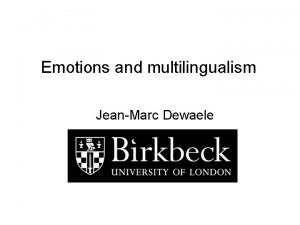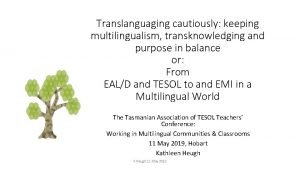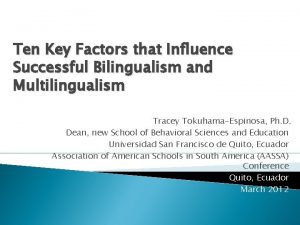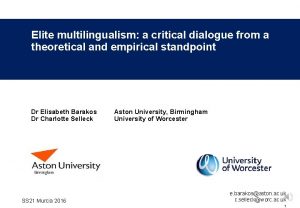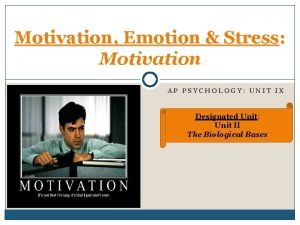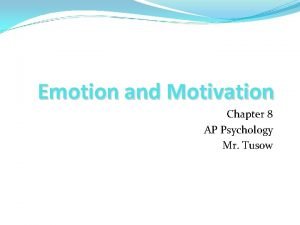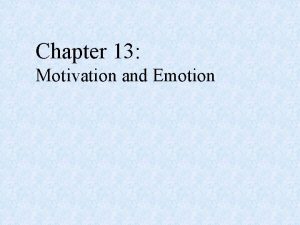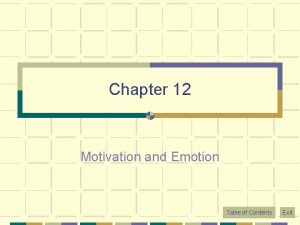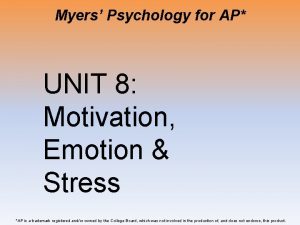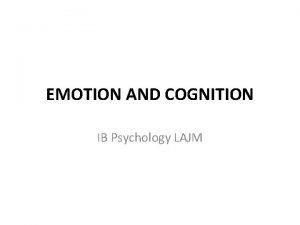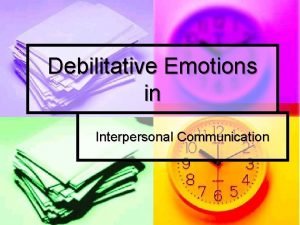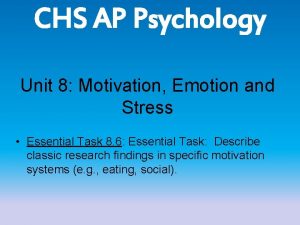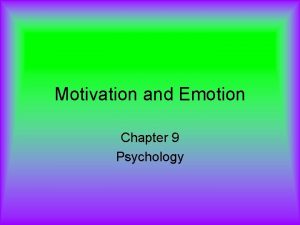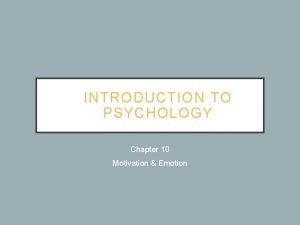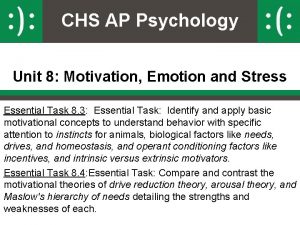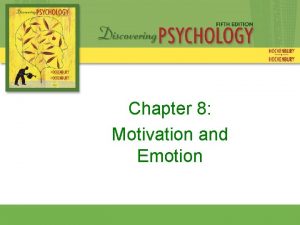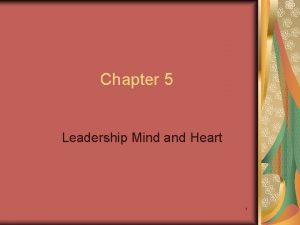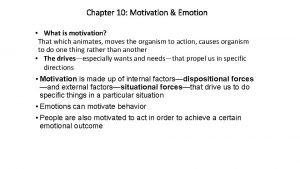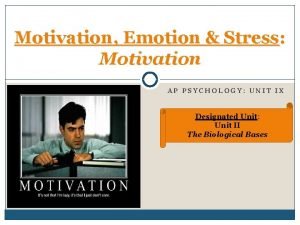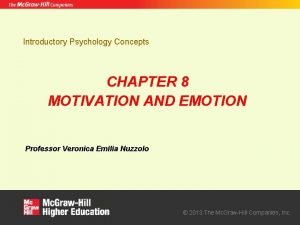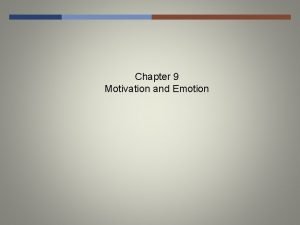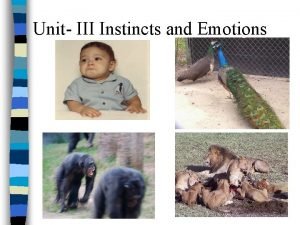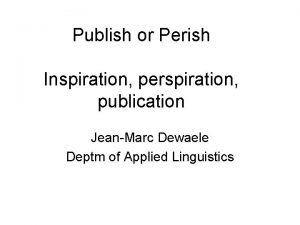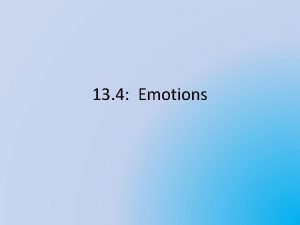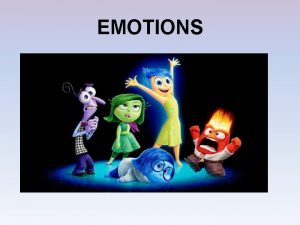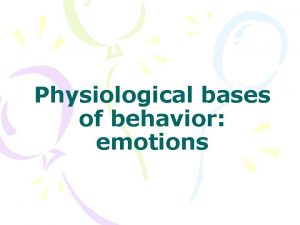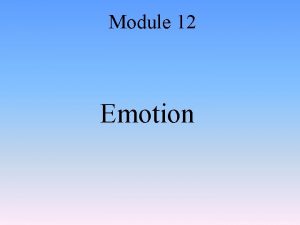Emotions and multilingualism JeanMarc Dewaele Definitions Emotion universal

























- Slides: 25

Emotions and multilingualism Jean-Marc Dewaele

Definitions • Emotion: universal, functional reaction to an external stimulus event, temporally integrating physiological, cognitive, phenomenological, and behavioral channels to facilitate a fitness-enhancing, environment-shaping response to the current situation (Keltner & Shiota 2003: 89) • Emotions do not live in a distinct part of the brain and are not universally expressed and recognised: they are constructed in the moment, by core systems that interact across the whole brain, aided by a lifetime of learning (Feldman Barrett 2017 How Emotions are made)

Definition of bi- multilingualism & bimultilingual Broad definition of bilingualism that includes: ‘not only the “perfect” bilingual (who probably does not exist) or the “balanced” ambilingual (who is probably rare) but also various “imperfect” and “unstable” forms of bilingualism, in which one language takes over from the other(s) on at least some occasions and for some instances of language use’ (Dewaele, Housen & Li Wei 2003: 1). Multilingual “in a broad, inclusive sense, in such a way that they include the concepts of bilingualism and bilingual within their respective ambits” (Aronin & Singleton 2012: 7)

L 1 & LX users “native/non-native speaker” has to be rejected because of the inherent ideological assumptions about the superiority of the former and the inferiority of the latter L 1/LX users: equal & complementary (Dewaele 2018) Traditional dichotomy: native speaker non-native speaker Cook’s 2002 innovation: native speaker L 2 user Dewaele 2018 L 1 user LX user variation in proficiency can exist within both L 1(s) & LX(s) & all individuals can be multicompetent users of multiple languages

2005 2010, 2 nd ed in 2013 (pb)

Communicating emotions • “The interpersonal communication of emotional states is fundamental to both everyday and clinical interaction. One’s own and others’ affective experiences are frequent topics of everyday conversations, and how well these emotions are expressed and understood is important to interpersonal relationships & individual well-being” (Fussell 2002)

Processing language, and emotions. . . • Emotional endolingual exchanges (L 1 -L 1 user): largely automatic language processing => focus on content of interaction (Paradis 2004) • Emotional exolingual exchanges (L 1 -LX user): more controlled processing for LX, searches for words, expressions, grammar rules, pragmatic rules, idioms & metaphors • => less attention on content & interlocutor, more risk of stumbling // trying to get hold of a bar of soap in a bathtub (Dewaele 2010)

Recognising emotions in recordings • Is it harder in an LX? (Lorette & Dewaele 2015, Alqarni & Dewaele, to appear) • Linked to LX proficiency? (Lorette & Dewaele 2015, 2018 a, b) • Cultural distance between L 1 & LX? (Lorette & Dewaele 2015, 2018 a, b) • Trait Emotional Intelligence? (Dewaele, Lorette & Petrides to appear) • Age of onset of learning LX? (Lorette & Dewaele 2018 b) • Modality? (Lorette & Dewaele 2018 a)

Emotion Recognition in Audio-only vs Audiovisual condition Lorette & Dewaele (2018 a) • 557 L 1 & 881 LX users of English from all over the world • Task: identify emotion (happiness, sadness, anger, fear, surprise & disgust) portrayed by L 1 English-speaking actress in 6 short recordings • // no difference between L 1 & LX users in audio-visual (Lorette & Dewaele 2015), effect of linguistic proficiency & cultural background

Language preferences & perceptions of multilinguals (Pavlenko 2005, Dewaele 2010) • 1564 multilinguals (Bilingualism & Emotion Questionnaire), Dewaele & Pavlenko 2001 -2003, language perception & language choice for communication of feelings, anger & swearing, self-perceived proficiency & Foreign Language Anxiety • L 1 typically preferred for communication of emotion • L 1 typically felt to have most emotional resonance

Language, emotions & cognition (Pavlenko 2012) • Affective processing in bilingual speakers reveal differential embodiment of L 1 & LXs • L 1(s): intense affective socialization in childhood: ‘a process of integration of phonological forms of words & phrases with information from visual, auditory, olfactory, tactile, kinesthetic, & visceral modalities, autobiographical memories, & affect’ (p 421) • L 1(s): automatic affective processing & heightened electrodermal reactivity to L 1 emotion-laden words • LXs: decreased automaticity, lower electrodermal reactivity to emotional stimuli • Strong secondary socialisation can dislodge L 1 from emotionally dominant position

Dewaele (2008) I LOVE YOU IS STRONGEST IN:

Loving a partner in a Foreign Language (Dewaele & Salomidou 2017) • Do language & cultural differences within cross-cultural couples make emotional communication more difficult? • Total 429 participants • 1/3: no difficulty! ½: limitations & lack of emotional resonance of LX • Minority: lack of genuineness at start of relationship => faded in months • Females: more difficulties in communicating emotions & feeling less authentic at start of relationship (faded) • Females more likely to adopt partner’s language • Interviews: 50% mentioned constraints of LX while 25% reported emotional liberation in LX

Pragmatic difficulties in communicating emotions with partner (Dewaele 2018 a) Pragmalinguistic: study of features of language use related to speakers' knowledge of structure & expressive resources of language itself rather than of social context Sociopragmatic: social perceptions underlying participants' interpretation & performance of communicative action 9% Pragmalinguistic 19% 40% Sociopragmatic Not language No problem 32%

Pragmatic difficulties in communicating emotions with partner (Dewaele 2018) Linguistic & pragmalinguistic issues • Participant 3 (female, 64, Japanese L 1, English L 2, Italian L 3) used English and Italian with her partner (his L 1) “I could not communicate my subtle feelings in a sophisticated manner. I felt what I was saying was rather blunt”. Sociopragmatic issues • Participant 8 (female, 33, Japanese L 1, English L 2 ) uses English with her partner (his L 1). “I often use silence as a sign of anger which is completely acceptable and usual in my culture but my partner wouldn’t get my intention at all. In fact, the silence makes the situation worse”. Not language, not culture • Participant 14 (female, 37, German L 1, English L 2, Italian L 3, Norwegian L 4) uses English with her partner. “I believe those instances are caused by differences in character and personality rather than language barriers”. No problem at all • Participant 18 (female, 21, Chinese L 1, English L 2, Spanish L 3) uses English with her partner who has Punjabi as an L 1. “Communication was actually easier in a non-native language (English) because this kind of shyness when expressing deep affection in my mother tongue (Chinese) was gone”.

Multilingual identity • Feeling different in different languages: – majority sometimes feel like a different person (Dewaele, 2016; Koven, 1998; Panicacci & Dewaele, 2017; Pavlenko, 2006) • Dual or hybrid self: – experiencing “a double self” vs. accepting a “sense of multiplicity” (Burck, 2004) – migrants’ reinvention through a “proxy self” (Thomas, 1995) “This language is beginning to invent another me” (Hoffman, 1989: 121) • Language status of minority languages: – intersection with “racialization processes” (Burck, 2004: 326)

Loss of language, loss of self? • Samata (2014) The Cultural Memory of Language: sense of inauthenticity felt by people who do not (or no longer) fully share a parent's L 1 • Sense of anger, need to assign blame • Linguistic and cultural exclusion • Consequences of positive self-image & well-being

Effect of conversation topic (neutral-personalemotional) on CS Friedman: Chi 2=65. 1, p <. 0001 (Dewaele 2010)

Direction of code-switching: typically LX => L 1 in emotional situations (Dewaele, 2010) Evy (Dutch L 1, English L 2, French L 3, dominant in L 1): My partner's L 1 is Berber but he's also good at Dutch (his L 2). So we argue in Dutch. However he sometimes switches to Berber without being aware of it. Cristina (Catalan L 1, Spanish L 2, English L 3, Italian L 4, German L 5, living in UK for nearly 20 years): If it’s a very critical situation (. . . ) then I would swear in in Catalan, my mother tongue.

Research questions • How are therapists working with multilingualism in the room? • Is this different for multilingual therapists and monolingual therapists? • How do therapists feel about patients occasionally speaking a language in the room which they do not understand?

Costa & Dewaele (2012): Psychotherapy across languages (Equality & Diversity Research Award (2013) British Association for Counselling & Psychotherapy) - 101 therapists (of which 19 monolingual), Mixed-methods - Multilingual therapists better able to attune ; Monolingual therapists more likely to collude (=> wanting to please) Dewaele & Costa (2013) 182 multilingual former clients • 1) Multilingualism of therapist linked to greater empathic understanding; • 2) Clients viewed their multilingualism as an important aspect of their sense of self & of their therapy; • 3) Language switches in therapy are more frequent when the emotional tone is raised: strategic use when discussing episodes of trauma & shame => gain proximity or distance according to the need

Rolland, Dewaele & Costa (2017) • 109 multilingual clients with mono/multilingual therapists • 59 clients had never discussed their languages with their therapist: It left some inhibited • => exhort therapists to make room for code-switching • => Training psychotherapists: Bager-Charleson, Dewaele, Costa & Kasap (2017) A multilingual outlook: Can awareness-raising about multilingualism affect therapists’ practice? A mixed-method evaluation. Language and Psychoanalysis 6, 56 -75 • Costa & Dewaele (2018) The talking cure – building the core skills and the confidence of counsellors and psychotherapists to work effectively with multilingual patients through training and supervision. Counselling and Psychotherapy Research Doi: 10. 1002/capr. 12187

Cook (in progress) • RQ: Can a LX contribute to the healing and reparative space offered by a therapeutic community for survivors of torture? • Interviews with 15 participants, members of Room to Heal, refugee & asylum seekers survivors of torture and other human rights violations

Conclusions • Languages are part of embodied cognition • They are not neutral tools for communication • They are part of a person’s identity and emotional DNA • Even proficient LX users may differ from L 1 users • Understanding the link between multilingualism and emotions is crucial for anyone dealing with LX users in emotional contexts (psychotherapists, detectives, hospital staff…)

Some references Costa, B. & Dewaele, J. -M. (2012) Psychotherapy across languages: beliefs, attitudes and practices of monolingual and multilingual therapists with their multilingual patients. Language and Psychoanalysis, 1, 18 -40. After winning the Equality and Diversity Research Award (2013) from the British Association for Counselling and Psychotherapy, revised and reprinted in Counselling and Psychotherapy Research, 2014, 14(3), 235 -244. Costa, B. & Dewaele, J. -M. (2018) The talking cure – building the core skills and the confidence of counsellors and psychotherapists to work effectively with multilingual patients through training and supervision. Counselling and Psychotherapy Research. Doi: 10. 1002/capr. 12187 Dewaele, J. -M. (2004) The emotional force of swearwords and taboo words in the speech of multilinguals. Journal of Multilingual & Multicultural Development 25, 204 -223. __(2013) Emotions in Multiple Languages. Basingstoke: Palgrave Mac. Millan __(2016) Why do so many bi- and multilinguals feel different when switching languages? International Journal of Multilingualism, 13, 92 -105. __(2018 a) Pragmatic challenges in the communication of emotions in intercultural couples. Intercultural Pragmatics 5, 29– 55. Dewaele, J. -M. & Costa, B. (2013) Multilingual clients’ experience of psychotherapy. Language and Psychoanalysis, 2(2), 31 -50. _Dewaele, J. -M. & Salomidou, L. (2017) Loving a partner in a foreign language. Journal of Pragmatics 108, 116 -130. _Lorette, P. & Dewaele, J. -M. (2018 a) Emotion recognition ability across different modalities: The role of language status (L 1/LX), proficiency and cultural background. Applied Linguistic Review Doi: 10. 1515/applirev-2017 -0015 _Lorette, P. & Dewaele, J. -M. (2018 b) The relationship between bi/multilingualism, nativeness, proficiency and multimodal emotion recognition ability. International Journal of Bilingualism. Doi: 10. 1177/1367006918808042 Pavlenko, A. (2005) Emotions and Multilingualism. Cambridge: CUP. Pavlenko, A. (2012) Affective processing in bilingual speakers: Disembodied cognition? International Journal of Psychology 47, 405– 428. Rolland, L. , Dewaele, J. -M. & Costa, B. (2017) Multilingualism and psychotherapy: Exploring multilingual clients' experiences of language practices in psychotherapy. International Journal of Multilingualism, 14, 69 -85.
 Types of individual multilingualism
Types of individual multilingualism Jean-marc dewaele
Jean-marc dewaele Horizontal and vertical multilingualism
Horizontal and vertical multilingualism Factors responsible for bilingualism and multilingualism
Factors responsible for bilingualism and multilingualism Elite dialogue
Elite dialogue Incentive theory ap psychology
Incentive theory ap psychology Cognitive appraisal psychology definition
Cognitive appraisal psychology definition Chapter 13 motivation and emotion
Chapter 13 motivation and emotion Chapter 12 motivation and emotion
Chapter 12 motivation and emotion Myers ap psychology unit 8
Myers ap psychology unit 8 Teacup ib psychology
Teacup ib psychology Debilitative emotions
Debilitative emotions Ap psychology unit 8 motivation emotion and stress
Ap psychology unit 8 motivation emotion and stress Ap psychology unit 8 test
Ap psychology unit 8 test Intrinsic and extrinsic motivation
Intrinsic and extrinsic motivation Chapter 10 motivation and emotion
Chapter 10 motivation and emotion Ap psychology unit 8 motivation emotion and stress
Ap psychology unit 8 motivation emotion and stress Appraisal psychology meaning
Appraisal psychology meaning Leadership mind and emotion
Leadership mind and emotion Chapter 10 motivation and emotion
Chapter 10 motivation and emotion Unit 8 motivation and emotion
Unit 8 motivation and emotion Ap psychology motivation and emotion activities
Ap psychology motivation and emotion activities Chapter 8 motivation and emotion
Chapter 8 motivation and emotion Incentive theory ap psychology
Incentive theory ap psychology Why are motives described as hypothetical states?
Why are motives described as hypothetical states? Characteristics of emotions ppt
Characteristics of emotions ppt

